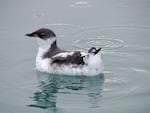
Marbled murrelets are seabirds that nest in older forests along the West Coast.
Rich McIntosh/U.S. Fish and Wildlife Service
After a deadlocked 3-3 vote, Oregon Fish and Wildlife Commission voted 4-2 Friday to elevate the marbled murrelet from a "threatened" species to "endangered."
The marbled murrelet is a seabird that nests in older coastal forests, and its population has been in a long-term decline in large part because of the loss of old growth trees to logging.
Several environmental groups petitioned the state to change the status of the bird. They told commissioners the bird's decline and ongoing loss of older forestland, together with other threats such as climate change and poor ocean conditions, will eventually lead to extinction.
But commissioners struggled to decide whether the species merited "endangered" status because the latest surveys don't show the population continuing to decline in Oregon in recent years.
In their first vote, commissioners Bob Webber, Bruce Buckmaster and Jim Bittle voted not to up-list the bird, but rather to develop a set of "survival guidelines" that would help guide a future decision on the species' status. Holly Akenson, Greg Wolley and Laura Anderson voted no.
"I'd rather up-list than do nothing," Webber said as commissioners debated what to do after the deadlocked vote.
Related: Endangered Orcas Are Starving. Should We Start Feeding Them?
Wolley made a motion to up-list the bird to endangered status, and it passed 4-2 with Buckmaster and Bittle voting no.
The decision triggers the development of "survival guidelines" for the species that will identify critical habitat sites, as well as strategies for protecting the bird to ensure the species' ultimate survival.
The commission will review those guidelines and officially reclassify the murrelet at its June meeting.
Some of the key nesting habitat for the marbled murrelet lies on state-owned forestland, and the Oregon Department of Forestry is in the process of updating the rules for how to manage logging near murrelet habitat.
Other protections could come at the expense of logging on private forestland.
Jim James, executive director of the Oregon Small Woodlands Association, urged commissioners not to up-list the murrelet when so much is still unknown and so many forestland owners could be negatively affected by new species protections.
"There’s a tremendous amount of research underway that will uncover some of the unknowns of marbled murrelets," he said. "Their populations are not in decline in Oregon. I think it's premature to say we know what to do until we learn more."
The marbled murrelet was federally listed as "threatened" in 1992 under the Endangered Species Act, and the state listed the bird as "threatened" in 1995 under state law. In recent years, the states of California and Washington have decided to up-list the species to "endangered" status.
Oregon Department of Fish and Wildlife strategy species coordinator Christina Donehower told the board that the birds usually nest in trees that are more than 80 years old, using existing cup-like tree structures covered in moss or lichen for their nests.
Related: Once-Vanished Fishers Are Making Their Comeback In Washington
Research shows older forests on the Oregon coast declined 58 percent from 1936 to 1996, Donehower said. Since then, suitable nesting habitat for the birds has continued to decline because of logging — even after the bird was listed as threatened. Overall, models show the murrelet population of around 11,000 birds in Oregon has about an 80 percent chance of going extinct in the next 60-80 years, Donehower said.
A key study of the murrelet population by Oregon State University is still ongoing, and many questions about the bird's nesting behavior and survival status remain unanswered, but Joe Liebezeit of the Portland Audubon Society told commissioners they should not delay their decision based on what they don't know.
"These birds are getting hit hard on land, and they’re also affected at sea," he said. "This is not a case where you can justify saying we need more data. We’ve been collecting data for years. The time to act is now."
In deliberating the decision, Buckmaster said he was concerned about the small timberland owners whose livelihoods might be put at risk by an unnecessary up-listing of the species without enough information.
"I keep hearing we need a plan," he said. "I agree with that. I'm not sure we need an endangered species plan."
Anderson said the fact that the murrelet straddles two habitats — on land and at sea — makes it even more vulnerable to the effects of climate change.
"I'm erring on the side of precaution on this," she said. "We need a plan for the bird and for ecosystem-based management in the long run."
